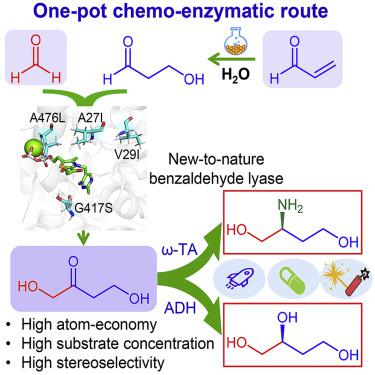Chem Catalysis ( IF 11.5 ) Pub Date : 2022-11-29 , DOI: 10.1016/j.checat.2022.11.006 Yu Li , Peiyuan Yao , Shiqing Zhang , Jinhui Feng , Hao Su , Xiangtao Liu , Xiang Sheng , Qiaqing Wu , Dunming Zhu , Yanhe Ma

|
While formaldehyde is an emerging C1 resource for the synthesis of high value-added chemicals due to its high and versatile reactivity, selective activation and controllable transformation of formaldehyde still remains a great challenge. In particular, coupling of formaldehyde with small aldehydes such as 3-hydroxypropanal offers excellent opportunity for constructing valuable molecules but has not been realized. A benzaldehyde lyase from Herbiconiux sp. SALV-R1 was engineered through directed evolution to achieve the coupling of 3-hydroxypropanal and formaldehyde. A carbonyl reductase and a transaminase were identified to catalyze reduction or transamination of 1,4-dihydroxybutan-2-one, a highly functionalized small ketone. The newly attained enzymatic hydroxymethylation and asymmetric reduction or transamination were then combined with the chemocatalytic hydration of acrolein in a one-pot process to synthesize optically pure 1,2,4-butanetriol and 2-aminobutane-1,4-diol from acrolein and formaldehyde. These results exemplify a new way for sustainable synthesis of high value-added chemicals from C1 molecules and simple starting materials.
中文翻译:

创造一种新的苯甲醛裂解酶,用于从甲醛中原子经济地合成手性 1,2,4-丁三醇和 2-氨基丁烷-1,4-二醇
虽然甲醛由于其高反应性和多功能性而成为合成高附加值化学品的新兴C1资源,但甲醛的选择性活化和可控转化仍然是一个巨大的挑战。特别是,甲醛与小醛如 3-羟基丙醛的偶联为构建有价值的分子提供了极好的机会,但尚未实现。来自Herbiconiux的苯甲醛裂解酶sp。SALV-R1 是通过定向进化设计的,以实现 3-羟基丙醛和甲醛的偶联。羰基还原酶和转氨酶被鉴定为催化 1,4-二羟基丁烷-2-酮(一种高度功能化的小酮)的还原或转氨作用。然后将新获得的酶促羟甲基化和不对称还原或氨基转移与丙烯醛的化学催化水合相结合,通过一锅法从丙烯醛和甲醛中合成光学纯的 1,2,4-丁三醇和 2-氨基丁烷-1,4-二醇. 这些结果举例说明了从 C1 分子和简单起始材料可持续合成高附加值化学品的新途径。































 京公网安备 11010802027423号
京公网安备 11010802027423号